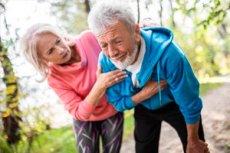New publications
Chances of survival for a sports-related heart attack are significantly higher
Last reviewed: 02.07.2025

All iLive content is medically reviewed or fact checked to ensure as much factual accuracy as possible.
We have strict sourcing guidelines and only link to reputable media sites, academic research institutions and, whenever possible, medically peer reviewed studies. Note that the numbers in parentheses ([1], [2], etc.) are clickable links to these studies.
If you feel that any of our content is inaccurate, out-of-date, or otherwise questionable, please select it and press Ctrl + Enter.

A study conducted at the University of Gothenburg has shown that most cases of sudden cardiac arrest (SCA) during sports activities are preventable and that emergency care using cardiopulmonary resuscitation (CPR) and defibrillators in a sports context can be significantly improved.
Cardiac arrest statistics in Sweden
Every year, Swedish emergency services record approximately 6,000 cases of sudden cardiac arrest outside of hospital settings, including at home, in the workplace and elsewhere. Of these, approximately 400 cases occur in the context of sports.
In her dissertation at the Sahlgrenska Academy at the University of Gothenburg, PhD student and cardiologist Matilda Frisk Thorell examined in detail the emergency care and prognosis for people who have experienced a SCD during sports.
Survival in Sports VSO
The chances of survival are significantly higher in sports-related cardiac arrest, especially if it occurs in sports facilities. At 30 days after the event, the survival rate was 56%, compared to only 12% for all cases of out-of-hospital SCA.
Delay in using a defibrillator
Early CPR and defibrillation using an automated external defibrillator (AED) are critical. However, the analysis found that even in sports venues, the availability of a defibrillator was not reached until 10 minutes after the incident. Despite the fact that the majority of victims (73%) had an acute abnormal heart rhythm (ventricular fibrillation), in which a defibrillator can be life-saving, only 14% of young people under 35 were connected to a public defibrillator before emergency services arrived.
"We can further increase survival rates by equipping more sports facilities with public defibrillators and training more people to recognize cardiac arrest, perform CPR and use a defibrillator," said Matilda Frisk Thorell.
Gender differences in prognosis
Cases of SCD in women were rare, accounting for only 9%. However, their chances of survival were lower: after 30 days, women had a 30% survival rate, compared to almost 50% for men.
Reasons for gender differences:
- Women were more likely to exercise alone or with fewer people.
- Help began to be provided later.
"We noticed that it took significantly longer for women to initiate CPR. This suggests a need to better recognize sports cardiac arrest in women and not be afraid to initiate resuscitation," the researcher added.
Young People and the VSO
Among young people who died from sudden cardiac arrest caused by a primary arrhythmia:
- 50% had previous symptoms.
- 20% had ECG changes before the event.
Fainting and convulsions are important symptoms that require response.
"Young people involved in sports at a professional level should undergo screening, including an ECG. This will help identify those at risk in order to give recommendations for further sports participation and possible treatment," concluded Matilda Frisk Thorell.
